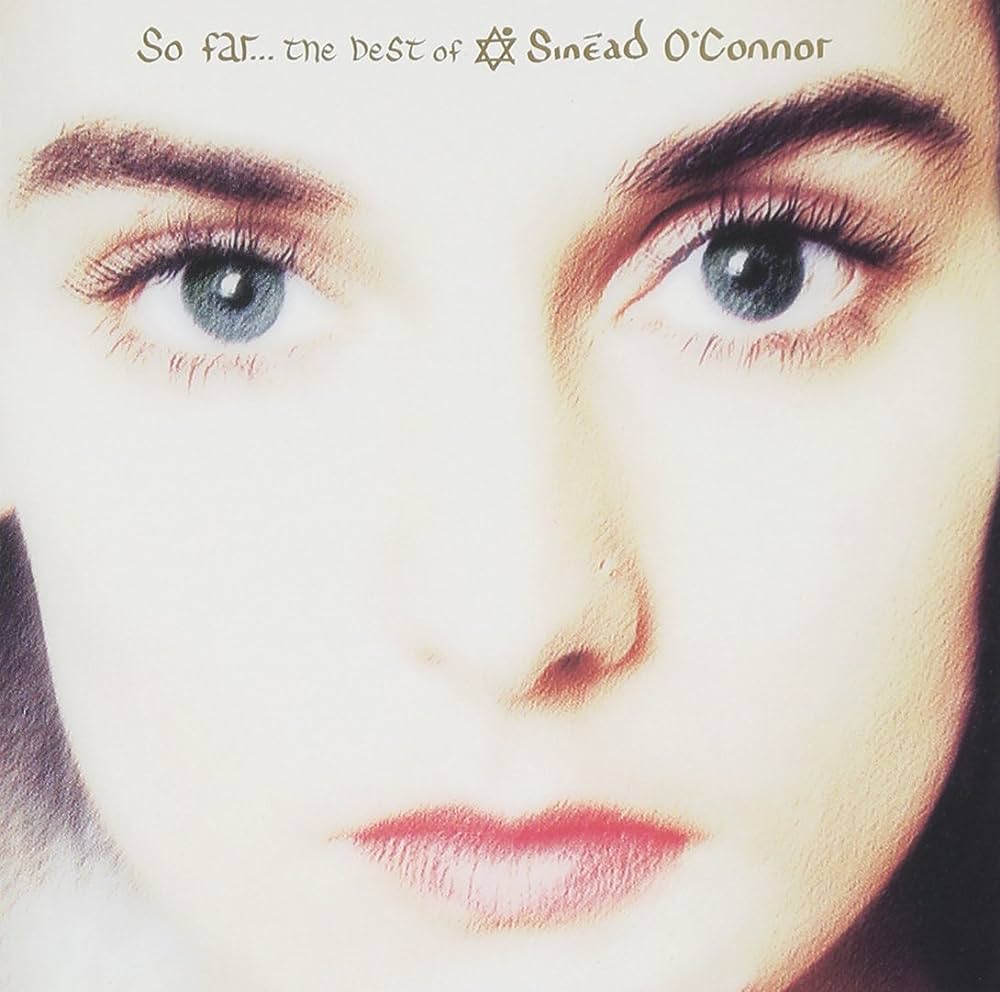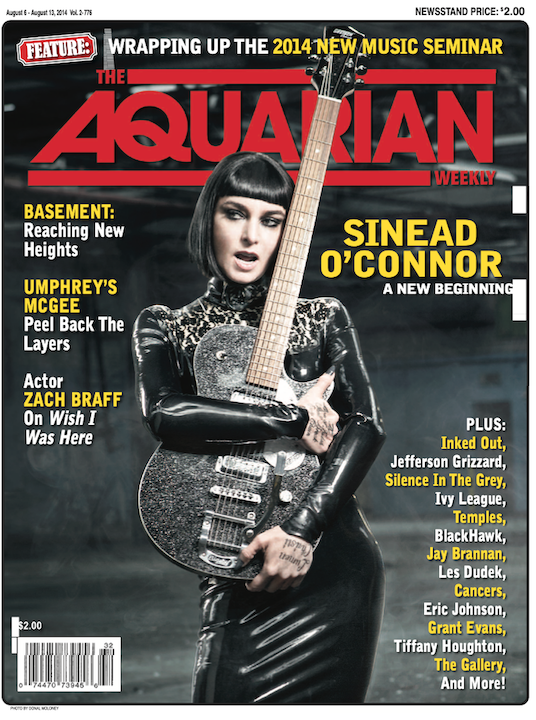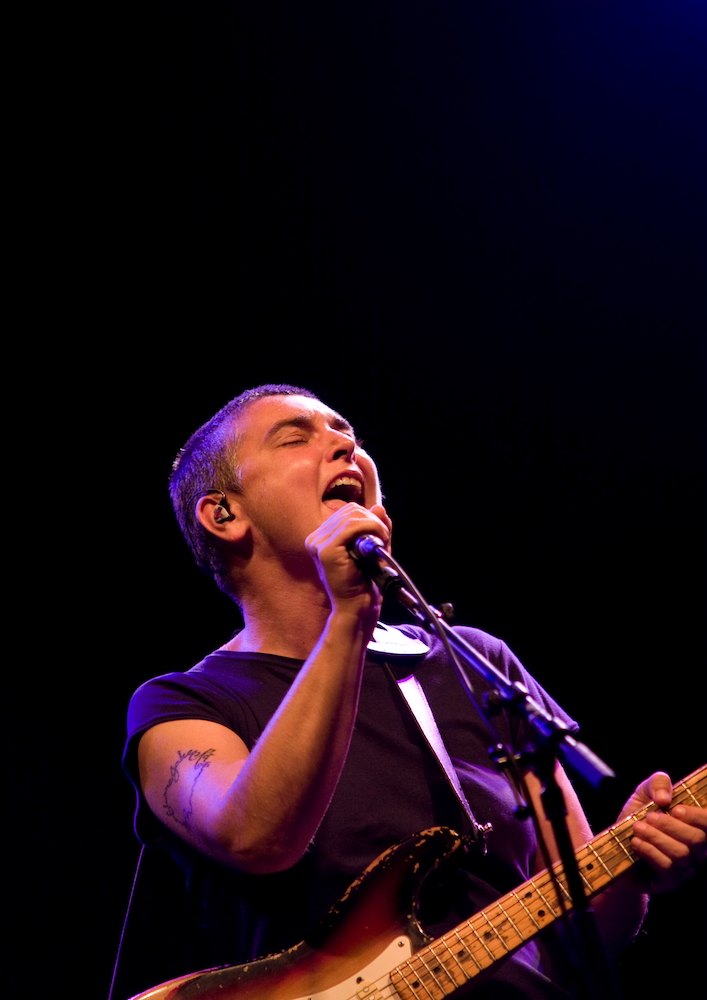Sinéad O’Connor was my hero.
Wait. I can’t leave my wife out of this. Erin D. Moore and I would not have sealed our bond, the one that has lasted 26 years – 24 in marriage – with a gorgeous, strong 15-year-old daughter, Scarlet (who briefly could have been named Sinéad) if not for O’Connor’s voice, her music, and the minuscule freak conclave of which we were, are, and will forever be proud members of.
I had an extra ticket to see her play at the Beacon Theatre in NYC. No one gave a shit about Sinéad O’Connor in August of 1997, except, apparently my bride-to-be and yours truly. Two years later, “This is to Mother You,” from her wonderful 1997 EP Gospel Oak (the album O’Connor was touring when the two of us went to see her together, was what turned out to be our first time alone together and the last time I would ever be alone again), was our wedding song.
Yeah, Sinéad was our hero.
She became mine much earlier. When I needed her – like I needed Warren Zevon when Zevon stepped in – she arrived like a gale force wind, horrifically refreshing.
Haunted by demons from her earliest sentient memories, defiant and reborn with a voice that coursed through your guts, Sinéad O’Connor pushed hard against what she thought was wrong and embraced with maternal aggression what she cherished. She was a holy mess, a furious angelic punk, and when you spoke to her, as I did, you can still hear the tremors of those battles in her throat; the almost whispered Gaelic pulse of words and breath that exploded into a thousand points of light when she sang. It was in her conversation that the spastic duality which fueled her art might be glimpsed.

She put it into the songs, on those albums, and when you saw her live – wholly present, like watching a reed dan le déluge – trying so damn hard to be the tough Irish lass but refusing to harden her heart. She needed that tool for the art, but, as many of us know, it’s a painfully arduous balancing act.
I could hear it in her voice, on stage, on record, over the phone.
Sadly, this week, she lost her balance.
When I wrote Prince Rogers Nelson’s eulogy for this paper in 2016, I spent a good part of it explaining what his music and times meant to the 20-something me. Well, Sinéad owned a good deal of the latter part of my twenties into my thirties, from the opening notes of “Nothing Compares 2 U” – a song I adored in 1986 when Prince strangely handed it to one of his fringe bands, the Family, instead of recording it himself – flooding out of the speakers of the shitty car I was driving towards dawn. It was revelatory, a shuddering tightrope declaration of pure adrenaline and hurt. Prince, no fan of O’Connor’s, understood the song belonged to her now. He said then, “Sometimes a song doesn’t find a home until it does, and this one has.” Because when she sings, “All the flowers that you planted, mama, in the backyard / All died when you went away,” Prince knew the score.
“Nothing Compares 2 U” went on to be a massive, global, No. 1 hit with a video in the how-nuts-can-we-get age that featured only her face. It is the first track on the second side of O’Connor’s second album. I Do Not Want What I Haven’t Got, one of the finest statements by a woman singer-songwriter ever, and when I was working on a pitch to the editors over at the 33 1/3 series three years ago to write about the record, I pointed out how pertinent it was to the women’s movement of nineties power pop, rock, and indie expression – from Liz Phair to Ani DiFranco, P.J. Harvey to Alanis Morrisette, and bands like Bikini Kill and Hole.
There would not have been that album or the Prince cover if not for the death of her mother, Johanna, who had suffered all her life from mental disorder shoved aside in a patriarchal, fascist state that was 1960s Ireland – no contraception or reproductive rights, no legal recourse against “marital rape,” laws against married women working, laws against battered women leaving their husbands, women disallowed from drinking in pubs. Sinéad watched her descend into madness and endured her ghastly mental and physical abuse, forcing her to a nunnery where she found her voice, learned guitar, and escaped to London at 16 to make her way. When Johanna died it was as if the talons of a great predatory bird had lifted from her 18-year-old soul and allowed her once again to breathe and to grieve.
The songs on that album are as arresting as anything that had come from a male artist. Male artists cannot be this vulnerable, as much as they might try. Prince tried, and he wrote a damn fine song (arguably his best ballad), but it took Sinéad to see it was not a torch song, but a paean to past regret and the desperate need for a wayward kid to belong. Prince later admitted it was as much about his complicated relationship with his mother and the insular emotional cocoon he’d erected to survive a peripatetic childhood than a woman he was pining for.
Watch the video again. Sinéad begins to cry when she sings that line about flowers in her mother’s garden dying. The honesty of it is terrifying. In her infinite duality, Sinéad O’Connor sang “Nothing Compares 2 U” as she sang her own sad, pure, fierce songs: tenderly, but so fucking strong. That is what you got from Sinéad O’Connor from the very beginning to the bitter end. The balance was as remarkable as it was unsustainable.
This is the same woman who refused to allow New Jersey’s Garden State Arts Center (now PNC Bank Arts Center) to play the national anthem before her show. I was there that night. We did not hear about this so-called fracas until the next day. (What concert have you ever been to that played the national anthem? Anthems are stringent jingoism.) O’Connor’s music is infinite – borderless. She took the stage, bald and thin, inflamed by the rush of music and put on a show for the ages, and when we all awoke, she was an instant pariah. Front page news. Outraged politicians. Frank Sinatra threatened to “kick her ass.” And in the swirl of that media frenzy, she proved her point: violence, vengeance, and patriarchal lunacy comes with all the “home of the brave” stuff just like pedophilia and systemic control over women in Northern Ireland. It came with the Catholic Church, and so, when she appeared on Saturday Night Live two years later and ripped up a photo of Pope John Paul II – the same one that hung on her mother’s wall when she was a child – while announcing “Fight the real enemy,” it officially tanked her career.
It was as if she had killed the man. The backlash was brutal, and it came from everywhere. A few days later, she stood on stage and listened to 20,000 New Yorkers, not KKK Alabamans, boo her mercilessly as she shouted Bob Marley’s “War” – the same furious a cappella performance that presaged the torn photo – with unrepentant rage before falling into Kris Kristofferson’s arms. She was to sing at some Boomer celebrity 30th anniversary circle-jerk for Bob Dylan, who used to get the same shit from people for singing about the murder of Emmitt Till, a young Black kid massacred for purportedly looking at a white woman. (In fact, in 1963, when honored at a Bill of Rights Dinner for his contributions to the Civil Rights movement, the 21-year-old Dylan took to the dais and unleashed a drunken diatribe alerting the rich liberals before him to find another “voice of a generation.” He was out of that game. Too dangerous.)
Sadly, but predictably, Dylan said nothing of the incident that overshadowed his stupid shindig, much to the consternation of many of his fans, including my friend, professor Tim Riley, who dedicated a chapter in his Hard Rain: A Dylan Commentary to the glaring omission and its painful irony. The next week, actor Joe Pesci hosted SNL and ripped up a picture of O’Connor and threatened to “give her such a smack.” She needn’t say anymore.
Enough about that and enough about women speaking their minds against patriarchal madness, racism, pogroms on women’s rights – all of which Sinéad stood against even after she was declared a dead pop star. “I never wanted to be a celebrity. I’m a fucking protest singer,” she told Rolling Stone when she simultaneously won Artist of the Year and Most Hated Artist in the same issue. It was in O’Connor’s ensuing work that she spoke the loudest – her constant battle with faith, be it Catholicism or Rastafarianism or Islam. She became a priest and a shaman, then changed her name, but she could have been a sixth Marx Brother or the fifth Beatle or submerged into X for all that mattered, because her truest spirit came from that uniquely quivering, impenetrable, irrepressible bottomless throat. From that machine emerged multitudes: lyrics and melodies bursting with love and peace and heartbreak and independence.
She often sang about her children. She had four; the first one, Jake, was born when she was only 21. She was allegedly asked to abort the fetus by her management as her career was about to blow up. “Who wants to see an unmarried pregnant pop star?” This was the same management who previously suggested she wear provocative clothing and do up her hair before she showed up with a shaved head and a dirty t-shirt. She was barely 20 then. Jake is 31 now. She lost her third, Shane, a troubled 17-year-old, last January. Haunted like his mother, like her mother’s mother, he hung himself. Sinéad O’Connor never recovered. Soon after, she was on suicide watch. She went missing and ended up here in New Jersey last summer. We tried to reach out to her, to find her. She came back, but barely. She’d recently popped up on Twitter under a pseudonym, her last tweet to the world was of Shane, “Been living as undead night creature since. He was the love of my life, the lamp of my soul. We were one soul in two halves. He was the only person who ever loved me unconditionally. I am lost in the bardo without him.” Nine days later, she was gone.
How delicate the balance.
And so, we are left with the songs and the memories of those incredible performances, as well as her marching for Black lives, women’s lives, Irish lives, human lives. Long after the shaved head and combat boots, long after her front-page stint as punk-warrior-demon-bitch, she kept singing (all those records are gems) and miraculously kept up the fight. Depression. Fear. Defeat. Resurrection. None of it silenced that astonishing singing voice. To this day, whenever I hear her hit those beatific notes on her stunningly gorgeous ballad “Three Babies,” the feathered dance of falsetto on the sultry “Jerusalem,” the building sprint of “Thank You for Hearing Me,” the naked passion of “The Last Day of Our Acquaintance,” the gritty harangue of “No Man’s Woman,” the whispered gauntlet in “Petit Poulet,” the lilting grace of “Jealous,” or our wedding song, the sweet, compassionate, agonizingly expressive, “This is To Mother You,” I feel – we feel – as if we are in there with her.
There is too much to say and I am shocked I got this out, because the first draft read like a man on the edge of a complete breakdown, but I need to share the last time I spoke directly with Sinéad.

It was in 2014 for an Aquarian cover story on her last album, I’m Not Bossy, I’m the Boss. My wife and I had just gotten back from Ireland to celebrate our 15th anniversary (as we both share Irish blood). Sinéad and I spoke about a mural outside of Dublin’s Hard Rock Café. It was a stunning painting of her with an inscription that read, “Sinéad, you were right all along, we were wrong. So sorry.” This trailblazing woman was so moved she stopped for a moment and took a long breath. “It’s very special to me,” she said. “I’d really love to know who did it.” I told her we all did and she laughed. I kept that part out of the piece. It was maudlin then, but it is so apt now.
I finally asked her about her disturbing ‘suicide’ song on the album, “8 Good Reasons” in which she sings, “Don’t know if I should quite sing this song / Don’t know if it maybe might be wrong / But then again it maybe might be right / To tell you ‘bout the bullet and the red light.”
“Can you reveal the eight good reasons that are worth sticking around for?” I asked.
Without hesitation, she whispered, “My children’s eyes.”
She lost her balance, that’s all.
She is still my hero.
Our hero.



